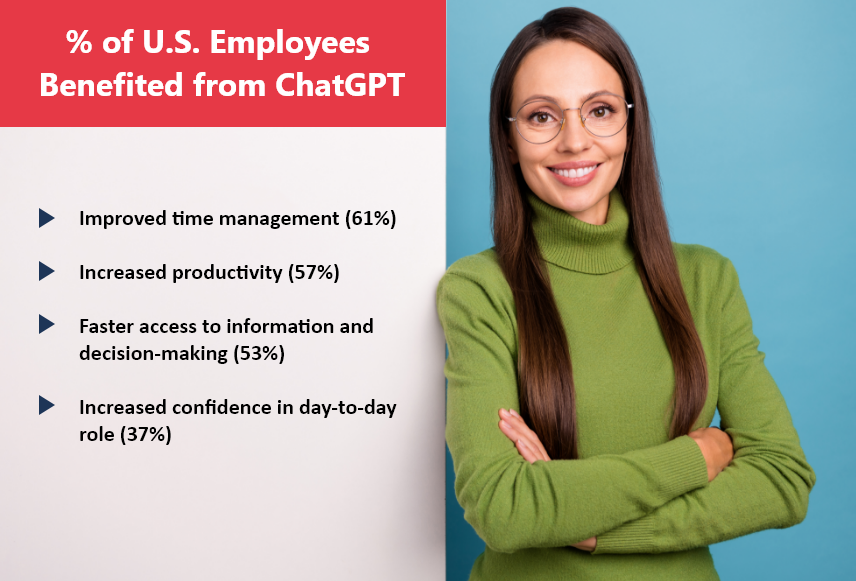
In the evolving HRTech landscape, it is crucial to learn about the use of Generative AI in HR to stay ahead of the curve and attract, develop, and retain top talent. As technology continues to revolutionize the HR industry, organizations are exploring the various HR applications of Generative AI to streamline HR processes and increase their strategic impact.
However, enhancing HR processes with Generative AI requires careful planning, ethical considerations, and deep understanding of the best practices involved. In this blog post, we will delve into the best practices of using Generative AI for HR. We will also take a glance at how Generative AI is transforming workplaces by paving the way for a more efficient, data-driven, and people-centric future.
Rise of Generative AI in the Workplace
The increasing popularity and adoption of Generative AI has created excitement among employees because of its many benefits. With its ability to analyze data, generate content, and provide valuable insights, Generative AI has become a powerful tool that can significantly enhance workplace productivity, efficiency, and innovation.
There are some research findings that reinforce this idea. A recent survey by TalentLMS reveals some interesting findings about the use of ChatGPT in the workplace.

A Nobel laureate and professor at the London School of Economics, Christopher Pissarides indicates that the ChatGPT revolution could pave the way for a four-day work week. ChatGPT does provide a significant productivity boost for a range of jobs.
While the promises of AI-driven HR practices are enticing, it’s important not to lose sight of organizational goals. To ensure the best use of Generative AI in HR and achieve positive outcomes, organizations must delve deeper into the HR applications of Generative AI.
HR leaders need to understand how Generative AI supports employees and identify any potential limitations or challenges it may pose. They also need to learn about leveraging Generative AI for talent management and improving employee engagement with Generative AI. A holistic approach is critical to effectively integrating Generative AI into HR processes and the workplace.
Use of Generative AI in HR: 10 Most Recommended Practices
Generative AI has the potential to bring significant advancements and transformations to the HR industry. However, it requires organizations to implement ethical considerations in AI for HR responsibly.
Generative AI, when used as a complementary tool, can enhance HR decision-making and improve employee experiences, ultimately driving positive organizational outcomes.
The following are the best practices of using generative AI for HR. Organizations can implement these most recommended practices to enable effective use of Generative AI in HR, while safeguarding against biases, ensuring privacy, and fostering transparency.
1. Define the Purpose Clearly
Before implementing Generative AI in HR, clearly define the specific purpose and objectives you want to achieve. Whether it is improving candidate screening, employee engagement, or performance evaluation, having a clear focus will guide your implementation strategy well.
2. Ensure Data Security and Privacy
Data security and privacy are critical and risky concerns of HR. When thinking about the use of Generative AI in HR, ensure the data is secure and the right privacy policies are in place. It is crucial to work with reputable vendors with robust security protocols, and ensure the data is encrypted and protected against unauthorized access.
Revolutionize HR with the power of LLM and Generative AI!
3. Provide Transparency
The effective use of Generative AI in HR requires organizations to not only ensure HR teams, but also other employees have enough visibility across necessary procedures. Employees should understand how Generative AI is used in HR processes and how it impacts their employment. Providing transparency will help build trust between employees and HR.

4. Use Diverse and Inclusive Dataset
When training Generative AI models, it is essential to use diverse and inclusive data. This can help HR professionals maintain fairness and avoid existing biases in the workplace. HR can generate error-free information by analyzing and customizing Generative AI algorithms.
5. Monitor and Evaluate AI Tools
HR should regularly review the outcomes generated by Generative AI models and ensure they align with the organization’s objectives. It is essential to gather feedback from employees and use it to improve the effectiveness of the Generative AI models.
6. Augment Human Judgment, Not Replace
Generative AI should be seen as a tool to augment human judgment, not replace it entirely. HR professionals should be allowed to have a major part in decision-making. They can use AI-generated insights as valuable input in addition to their expertise.
7. Address Bias and Fairness
Pay careful attention to potential biases in Generative AI algorithms. Ensure fairness and avoid perpetuating biases related to gender, race, or other protected characteristics. Regularly audit the algorithms for bias and implement necessary corrections.
8. Ethical Considerations
Incorporate ethical considerations into the development and deployment of Generative AI in HR. One of the ways to ensure the best use of Generative AI in HR is to consider its potential impact on employee privacy, autonomy, and well-being. Develop guidelines and safeguards to prevent misuse and ensure responsible use of AI-generated insights.

9. Continuous Learning and Upskilling
As Generative AI evolves, HR professionals must stay updated on the latest advancements and understand the underlying principles. Invest in training and upskilling programs to ensure HR teams effectively leverage Generative AI and adapt to changing technologies.
10. Scalability and Adaptability
The effective use of Generative AI in HR requires organizations to design Generative AI solutions that are scalable and adaptable to evolving organizational needs. Consider the long-term implications and potential integration with other HR systems. Plan for scalability to accommodate increased data volumes and changing business requirements.
Time to Make Best Use of Generative AI in HR
In the rapidly evolving business landscape, Generative AI stands out as a truly transformative force comparable in significance to the advent of the internet. Ignoring or underestimating its capabilities can lead organizations and their leaders to fall behind the competition, while those who embrace and harness this technology are poised to flourish.
While Generative AI is not without its challenges, its potential is immense. As adoption rates continue to rise, we can anticipate a wave of innovative and unconventional applications that will further push the boundaries of what is possible. However, the window of opportunity may close for those who delay their entry into this realm, leaving them on the sidelines while others revel in the benefits of Generative AI.
The time to act is now. Embracing the use of Generative AI in HR can open doors to new possibilities, enhance competitiveness, and empower organizations to navigate the ever-changing business landscape with confidence.
Are you looking to enable HR automation with Generative AI or harness the potential of machine learning in HR? Contact our HRTech experts at contact@harbingergroup.com.






